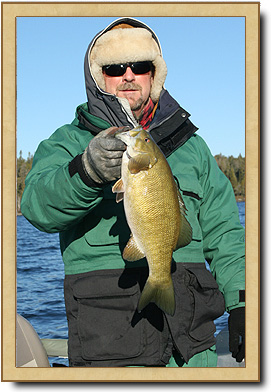|
Smallmouth Bass Fishing Tips for Eagle Lake:
Smallmouth Bass are generally very easy to catch. Their feeding habits are affected by wind and weather more than time of year. In the spring we are catching 4 and 5 pounders right off the dock. At this time of year they are hungry and hit just about anything. The location of Birch Dale Lodge on Eagle Lake is the hottest Smallmouth Bass area in the whole lake and could be called one of the top places in Ontario for big Trophy Smallmouth Bass.
Still Days: On still days when the water surface is like glass, the Smallmouth Bass are feeding but they tend to explore their area and get spread out. Sometimes baitfish will feel too vulnerable and head deeper into darker water and the Smallmouth Bass will follow them. If you are not hitting fish at rocky points or over rocky shoals, try covering some area and troll along the shore about 15 yards out and cast towards shore with small black Mepps Furies or Blue Rapalas or Blue Thundersticks.
If the bass have gone deeper, try sinking blue, black or worm-colored tub jigs off in the deeper water that is just off the shoal or rocky point.
|

|
Windy Days: When it's windy and sunny, that is the very best time for Smallmouth Bass. Normal behavior is to patrol around and on top of the shoals. When it's windy, the Smallmouth Bass will move to the backside of the shoal on the opposite side of where the waves are hitting the rocks. This is also true for points. The bass will move to the backside of the point. They may come up shallow or site back in 5 to 10 feet of water. You can cast with lures because they will keep their eye on the shallow water and come up and hit lures just under the surface. You can also try some lures that go deeper. The very best way to get the big Smallmouth is to get a good size bass hook and put on a big worm with no weight and cast out and let the worm slowly sink. What you can do is un-clip your bail and let the bass take the worm and run with it for 10 second before setting the hook. You can also use the same technique with a live minnow, if you are on a lake that allows live bait. Some of the biggest bass are taken this way.
When it's windy, Smallmouth Bass will also head towards a rocky shoreline. Depending on how big the waves are, the bass will sit off in 5 to 10 feet of water but stay close to were the waves are pounding the shoreline. Big waves bring in surface water, which attracts minnows. They also cause an oscillation in the water that the bass do not like. They site off-shore in quiet water but close enough to the turbulence to see unsuspecting prey.
Rain and low pressure: Generally the Smallmouth Bass will go deep and stop feeding when it's raining or if a low-pressure system moves into the area. They don't always stop feeding. In this case, try heavy tub jigs and fish a lot deeper. On small inland lakes, the bass will go 15 to 20 feet deep. On big lakes, people have found incredible success fishing 30 to 40 feet deep using jigs.
Sunny and Hot: In some lakes, the bass will hide in thick weeds. This is a good time to try weedless rubber baits like a Texas Rig or a Carolina Rig. These rigs are usually used for Largemouth Bass but can be effective for thick-cover Smallmouth Bass.
Small bass in the ½ to 3-pound range will school and stay in hunting packs. Generally the really big Smallmouth Bass that are 4-pounds and bigger will travel in mating pairs. They will also have a territory and try to keep the smaller bass out. If you find a spot that looks really good for bass and you are not catching any, most likely there is a pair or really big bass in the area. They are big because they are smart. Be very quiet and try casting with lures of jigs. If you don't get anything, leave the area for an hour and then come back quietly and try using some slow baits that will not spook them. A big worm on a hook with no weight is the very best.
